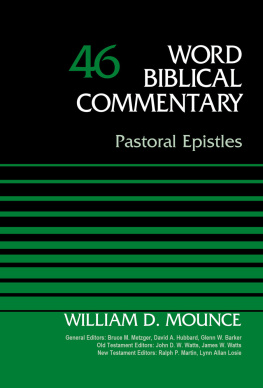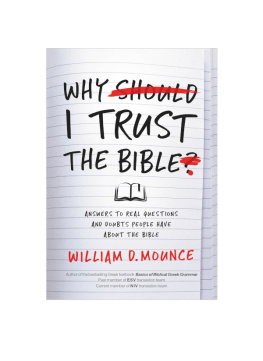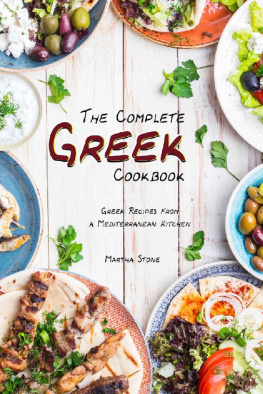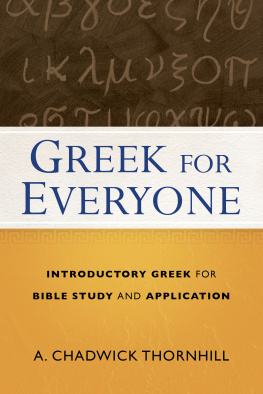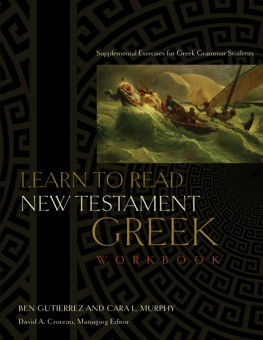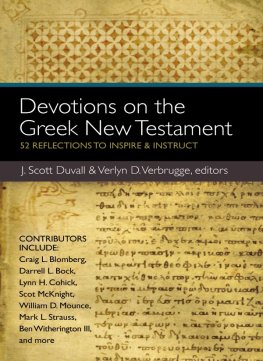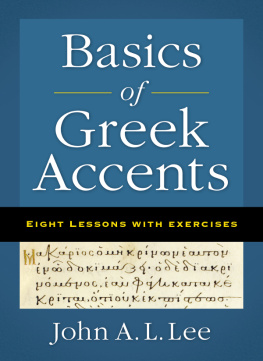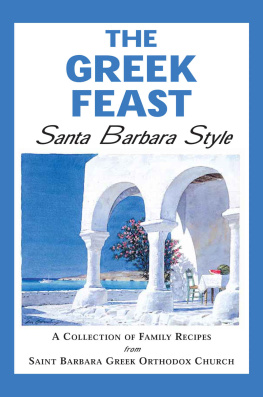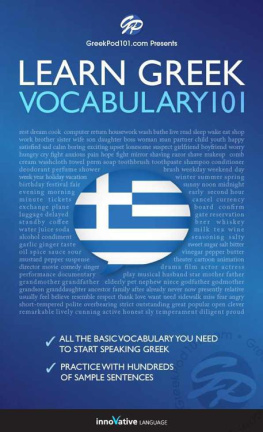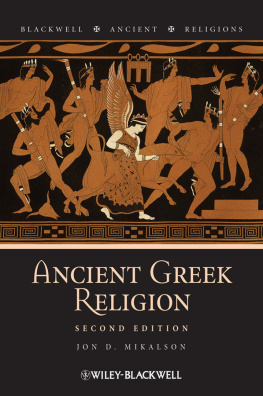
Second Edition
Greek for the Rest of Us
Also by William Mounce
Basics of Biblical Greek: Grammar
Basics of Biblical Greek: Workbook
A Graded Reader of Biblical Greek
The Analytical Lexicon to the Greek New Testament
Biblical Greek: A Compact Guide
The Morphology of Biblical Greek
The Interlinear for the Rest of Us
The Zondervan Greek and English Interlinear New Testament (NASB/NIV)
Mounces Complete Expository Dictionary of Old and New Testament Words
Pastoral Epistles (Word Biblical Commentary)
The Crossway Comprehensive Concordance of the Holy Bible
Second Edition
Greek for the Rest of Us
The Essentials of Biblical Greek
William D. Mounce

ZONDERVAN
Greek for the Rest of Us
Copyright 2013 by William D. Mounce
Requests for information should be addressed to:
Zondervan, Grand Rapids, Michigan 49530
Library of Congress Cataloging-in-Publication Data
Mounce, William D.
Greek for the rest of us: the essentials of biblical Greek / William D. MounceSecond edition.
p. cm.
Includes .
eISBN 978-0-310-51809-9
ISBN 978-0-310-27710-1 (softcover)
BiblicalGrammar. 2. Bible. New TestamentLanguage, style. I. Title.
PA817.M655 2013
487'.4dc23 2013023352
Scripture quotations marked NIV are taken from The Holy Bible, New International Version, NIV. Copyright 1973, 1978, 1984, 2011 by Biblica, Inc. Used by permission. All rights reserved worldwide.
Scripture quotations marked NASB are taken from the New American Standard Bible. Copyright 1960, 1962, 1963, 1968, 1971, 1972, 1973, 1975, 1977, 1995 by The Lockman Foundation. Used by permission.
The Scripture quotations marked RSV and NRSV are from the (New) Revised Standard Version of the Bible, copyright 1946, 1952, 1971, 1989 by the Division of Christian Education of the National Council of Churches of Christ in the United States of America, and are used by permission. All rights reserved.
Scripture quotations marked NLT are taken from the Holy Bible, New Living Translation, copyright 1996, 2004. Used by permission of Tyndale House Publishers, Inc., Wheaton, Illinois. All rights reserved.
Scripture quotations marked ESV are taken from The Holy Bible, English Standard Version, copyright 2001 by Crossway Bibles, a division of Good News Publishers. Used by permission. All rights reserved.
Scripture quotations marked NET taken from the NET Bible copyright 1996-2006 by Biblical Studies Press, L.L.C., www.bible.org. All rights reserved.
Any Internet addresses (websites, blogs, etc.) and telephone numbers in this book are offered as a resource. They are not intended in any way to be or imply an endorsement by Zondervan, nor does Zondervan vouch for the content of these sites and numbers for the life of this book.
All rights reserved. No part of this publication may be reproduced, stored in a retrieval system, or transmitted, in any form or by any meanselectronic, mechanical, photocopy, recording, or any otherexcept for brief quotations in printed services, without the prior written permission of the author.
for Big Terry
who deeply desires to know Gods Word better
but who does not have the time to learn traditional Greek
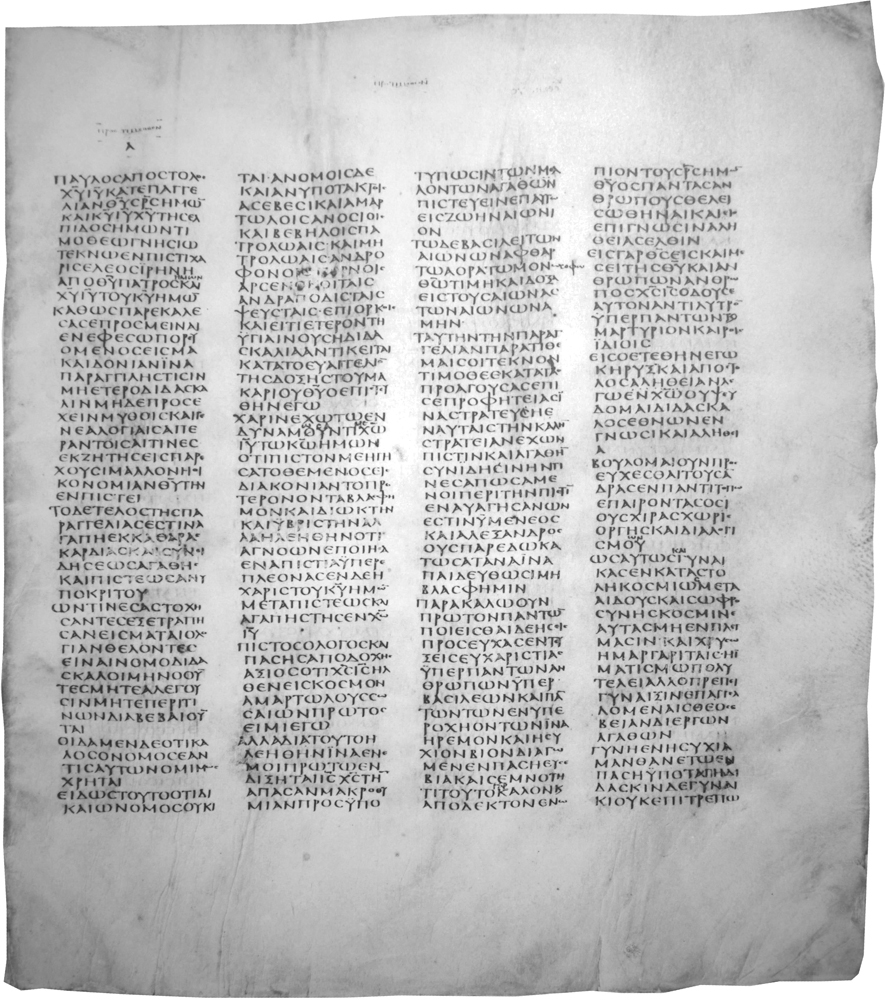
Codex Sinaiticus is an important majuscule manuscript from the 4th century. The images posted here are from the full-sized black and white facsimile of the manuscript produced in 1911 by Kirsopp Lake and Clarendon Press. The Codex Sinaiticus Project website (http://codexsinaiticus.org) has new images and information about this manuscript.
Image courtesy of the Center for the Study of New Testament Manuscripts
Table of Contents
Thank you for purchasing the HarperCollins Christian Publishing eBook version of Greek for the Rest of Us: The Essentials of Biblical Greek, Second Edition.
What is the difference between an eBook and a print book?
eBook versions contain all of the content and supplementary materials found in the original print versions and are optimized for navigation in the various apps and devices used for display. eReaders recognize text as one fluid string and are formatted in a single column. eReaders currently do not support the more complex layout seen in print version books. Therefore, some content may not appear in the same place as in the original print version, but it is structured consistently and uses hyperlinks to navigate between related content.
How do I use the eBook Table of Contents?
*Important Note: Be sure to consult your device manufacturers Users Guide for device-specific navigation instructions.*
The is the primary navigation anchor to quickly access various parts of the eBook. It is generally formatted in the same order as the original print version and is hyperlinked as follows:
Selecting an entry in the .
How do I navigate the content?
The eBook version of Greek for the Rest of Us, Second Edition includes as well as the main book text.
For the optimal viewing display of multi-column tables and Interlinear Passages, use the small to medium font sizes available on the device.
are hyperlinked directly to the content-specific location in the main text.
Select the hyperlinked entry in the Table of Contents to go to its location in the main text.
Select the hyperlinked entry in the main text to go back to the article or list in the Table of Contents or use the devices Back button or function to go back to the last selection.
Footnotes are marked with small, hyperlinked numbers 1 to access comments and citations.
Select the hyperlinked number in the main text to the corresponding footnote.
Select the hyperlinked number to the left of the footnote to go back to the main text or use the devices Back button or function to go back to the last selection.
entries are hyperlinked directly to the content-specific location in the main text.
Select the .
Select a letter A from the alphabet.
Use the devices Next Page/Previous Page button or function to scroll through the entries.
Select the hyperlinked page number 1 to go directly to the citation in the main text.
Use the devices Back button or function to go back to the last selection.
When people learn that I am a Greek teacher, one of the more common responses is, I have always wanted to learn Greek. (It may not be the most common, but it has happened repeatedly.) I always ask them why they want to learn Greek. To date, only one person has said he really wants to learn the language. What they want is to understand the Bible better, and especially to know what the Greek words behind the English translation mean.
In a perfect world, we would all know Greek and be able to understand the Bible better because we would not rely on translations. But the world is not perfect, and many people are not able to spend the years required to learn Greek properly, even those who have a seminary education.
As I thought about how I might help the situation, I came to the conclusion that if people knew a little about Greek and a lot about how to use the good biblical study tools, they could in fact glean much from the Bible and from other resources that are otherwise beyond their grasp. This includes:
Next page

